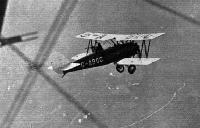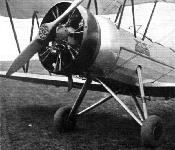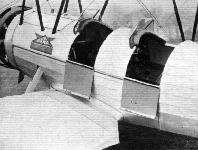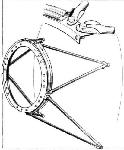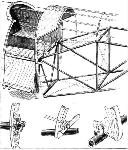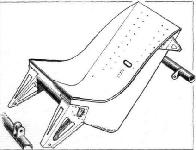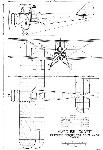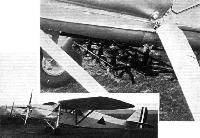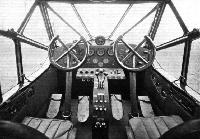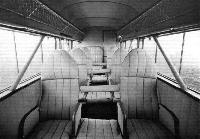Фотографии
-
A FINNISH SEAPLANE: The Kotka seaplane, manufactured at the Government aircraft factory in Finland and fitted with a Bristol "Jupiter" engine.
Самолёты на фотографии: VL Kotka - Финляндия - 1930
-
Регистрационный номер: NC12225 HIGH-SPEED AIR SERVICES: Varney Speed Lines, Ltd., operate a high-speed passenger and mail service between Los Angeles and San Francisco, a distance of 375 miles. Lockheed "Orion" monoplanes (450-h.p. Pratt & Whitney "Wasp") - one of which, "North Wind," is shown here - are used, and accomplish the journey in 1 hr. 58 min. at a speed of about 182 m.p.h.
Самолёты на фотографии: Lockheed Orion 9 - США - 1931
-
Регистрационный номер: G-ABGG FOR GUNNERY INSTRUCTION: An aerial view of one of the Avro 626 Advanced Training aeroplanes, showing the machine fitted up for instruction in observers' gunnery.
Самолёты на фотографии: Avro Tutor/Sea Tutor/Prefect / Type 621/646/626 - Великобритания - 1929
-
Регистрационный номер: G-ABRS Самолёты на фотографии: Avro Cadet / Type 631/643 - Великобритания - 1932
-
THE AVRO 631 "CADET": The front view shows the simple and clean design.
Самолёты на фотографии: Avro Cadet / Type 631/643 - Великобритания - 1932
-
REDUCING AIR DRAG: Behind the Townend ring is the exhaust collector ring, which in turn is separated by a large air space from the hemispherically-shaped nose of the fuselage. Note also the tripod undercarriage.
Самолёты на фотографии: Avro Cadet / Type 631/643 - Великобритания - 1932
-
EASY ENTRY AND EXIT: By dropping the top longerons of the fuselage, the cockpit doors can be made very deep, and both passengers can readily escape by parachute in case of emergency.
Самолёты на фотографии: Avro Cadet / Type 631/643 - Великобритания - 1932
-
EASILY DETACHABLE TOWNEND RING: Brackets fixed on the cylinder heads locate the ring, which is in two halves. On the ring are corresponding brackets, felt pads being interposed between the two brackets. Quick-release catches on opposite sides of the ring diameter can be undone in a few moments, and the two halves of the ring removed from the engine. The two halves of the ring are shown on the right.
Самолёты на фотографии: Avro Cadet / Type 631/643 - Великобритания - 1932
-
THE ENGINE MOUNTING: The ring supporting the "Genet Major" engine is carried on four steel tube vees, the apices of which pick up the ends of the four longerons. The curved tube on the ring, shown in the inset, locates the cowl-securing cable.
Самолёты на фотографии: Avro Cadet / Type 631/643 - Великобритания - 1932
-
SOME FUSELAGE DETAILS: Welded steel tube construction is used for the main structure of the fuselage. The top longerons are dropped in the centre portion to give deeper cockpit doors. The secondary structure is of wood, and attached to the primary structure by simple clips.
Самолёты на фотографии: Avro Cadet / Type 631/643 - Великобритания - 1932
-
SIMPLE SEAT SUPPORTS: No seat bearers are used, the seats being carried on two of the main structure cross tubes in the manner shown.
Самолёты на фотографии: Avro Cadet / Type 631/643 - Великобритания - 1932
-
Avro 631 "Cadet" Armstrong Siddeley 7-Cyl. Genet Major Engine
Самолёты на фотографии: Avro Cadet / Type 631/643 - Великобритания - 1932
-
OFFENSIVE "PUSS MOTHS": The Government of Iraq has ordered from the de Havilland Company a batch of "Puss Moths" fitted with bomb racks. Another version of this machine is fitted up as an aerial ambulance.
Самолёты на фотографии: De Havilland Puss Moth / D.H.80 - Великобритания - 1929
-
TO PROTECT THE HANWORTH GRASS! Col. the Master of Sempill has had his "Puss Moth" fitted out with a tail wheel instead of the standard skid. The wheel fork and bracket were designed and made in the workshops at Hanworth and the tyre is a small Goodyear airwheel. The fitting has been approved by Farnborough Authorities and can be supplied to anyone at a reasonable price.
Самолёты на фотографии: De Havilland Puss Moth / D.H.80 - Великобритания - 1929
-
Самолёты на фотографии: Westland Wallace / PV.3 / PV.6 - Великобритания - 1931
-
THE P.V.6: As a result of generally clean design, drag-reducing cowling, "spats" over the wheels, and other refinements, this new Westland machine, which is fitted with one of the new Bristol "Pegasus" engines, has a very good performance.
Самолёты на фотографии: Westland Wallace / PV.3 / PV.6 - Великобритания - 1931
-
GENERAL PURPOSES: Some of the many functions of the P.V.6 illustrated diagrammatically.
Самолёты на фотографии: Westland Wallace / PV.3 / PV.6 - Великобритания - 1931
-
Регистрационный номер: G-ABSC An Avro Avian just supplied to A.S.T. for instruction use at Hamble. This Machine is now fitted with Dunlop low-pressure tyres and the Armstrong Siddeley Genet Major Engine.
Самолёты на фотографии: Avro Avian / Type 594/616 - Великобритания - 1926
-
Регистрационный номер: G-ABPE Самолёты на фотографии: Comper Swift / CLA.7 - Великобритания - 1930
-
THE COMPER "SWIFT" (POBJOY ENGINE): These photographs show the machine which belongs to Mr. Selfridge. That used by Mr. Taylor in his flight was similar. The installation of the Pobjoy is shown on the left, while the photograph on the right shows that although the machine is diminutive, the pilot can take with him a fullsize suit case when he goes touring.
Самолёты на фотографии: Comper Swift / CLA.7 - Великобритания - 1930
-
Регистрационный номер: G-ABUO [2] TWO VIEWS OF THE "FOX MOTH": In spite of cabin accommodation for three passengers, the fuselage is by no means bulky.
Самолёты на фотографии: De Havilland Fox Moth / D.H.83 - Великобритания - 1932
-
Регистрационный номер: G-ABUO [2] FOLDING WINGS: Although making use of standard "Tiger Moth" wings, the main planes of the "Fox Moth" are arranged to fold.
Самолёты на фотографии: De Havilland Fox Moth / D.H.83 - Великобритания - 1932
-
SOME DETAILS OF THE DE HAVILLAND "FOX MOTH": The cabin arrangement is shown.
Самолёты на фотографии: De Havilland Fox Moth / D.H.83 - Великобритания - 1932
-
SOME DETAILS OF THE DE HAVILLAND "FOX MOTH": A view into the pilot's cockpit. The circular window communicates with the cabin. The wind screen consists of three triangles, and gives a marked absence of draught in the cockpit.
Самолёты на фотографии: De Havilland Fox Moth / D.H.83 - Великобритания - 1932
-
SOME DETAILS OF THE DE HAVILLAND "FOX MOTH": On the left, the undercarriage. The wheels are carried on stub axles, and the bracing struts have universal joints. On the right the castoring tail wheel.
Самолёты на фотографии: De Havilland Fox Moth / D.H.83 - Великобритания - 1932
-
TAKING CARE OF WOOD SHRINKAGE: Dished steel washers under all nuts ensure that pressure is maintained even when the wood under the plates has shrunk considerably.
Самолёты на фотографии: De Havilland Fox Moth / D.H.83 - Великобритания - 1932
-
SOME DETAILS OF THE DE HAVILLAND "FOX MOTH": The centre-section petrol tank and its supporting struts which form a letter M in end view and an N in side view. The supply pipe to the engine runs above the cabin top.
Самолёты на фотографии: De Havilland Fox Moth / D.H.83 - Великобритания - 1932
-
D.H.83 Gipsy III Engine
Самолёты на фотографии: De Havilland Fox Moth / D.H.83 - Великобритания - 1932
-
Регистрационный номер: VQ-FAA FROM FIJI: A Spartan (Hermes II) seaplane which Mr. Gordon Fenton has operated in the Fiji Islands for over 500 hours without any untoward events.
Самолёты на фотографии: Simmonds Spartan - Великобритания - 1928
-
Регистрационный номер: G-AAZE A True-to-Scale Model of the D.H. "Gipsy Moth" constructed from parts supplied by Aeromodels.
Самолёты на фотографии: De Havilland Gipsy Moth / Moth X - Великобритания - 1928
-
Регистрационный номер: I-SEBM A NEW ITALIAN TRANSPORT PLANE: The Breda 32 three-engined all-metal monoplane. Equipped with 320 h.p. Pratt & Whitney "Wasp Junior" engines, it carries a useful load of 5,940 lb. at a cruising speed of 131 m.p.h. Further details of this machine will be published later.
Самолёты на фотографии: Breda Ba.32 - Италия - 1931
-
CLEAN DESIGN: Front view of the Breda 32 showing the absence of excrescences.
Самолёты на фотографии: Breda Ba.32 - Италия - 1931
-
DUAL CONTROL: The pilots' cockpit not only affords an excellent view, in spite of the fuselage engine, but the arrangement of controls, instruments, etc., appears to have been given a good deal of thought.
Самолёты на фотографии: Breda Ba.32 - Италия - 1931
-
THE BREDA 32: View inside the cabin, looking aft. The central seats tip up to afford passageway for the other passengers. This feature is not likely to appeal to the majority of travellers.
Самолёты на фотографии: Breda Ba.32 - Италия - 1931
-
Breda 32
Самолёты на фотографии: Breda Ba.32 - Италия - 1931
Статьи
- Flight


